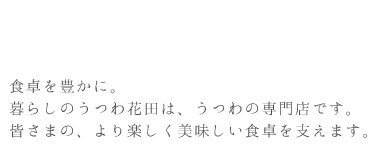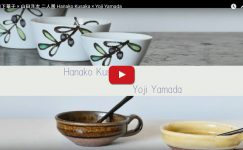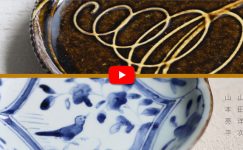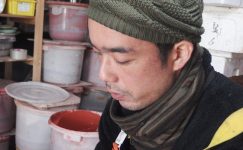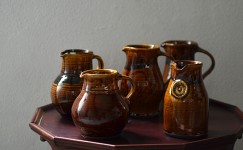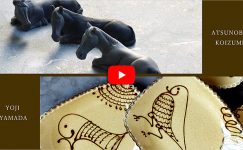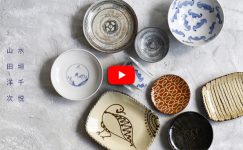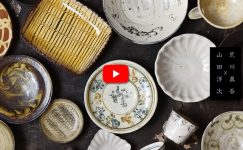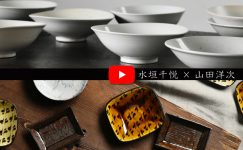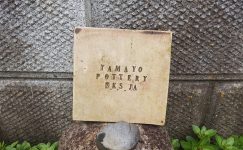English version of the interview here.
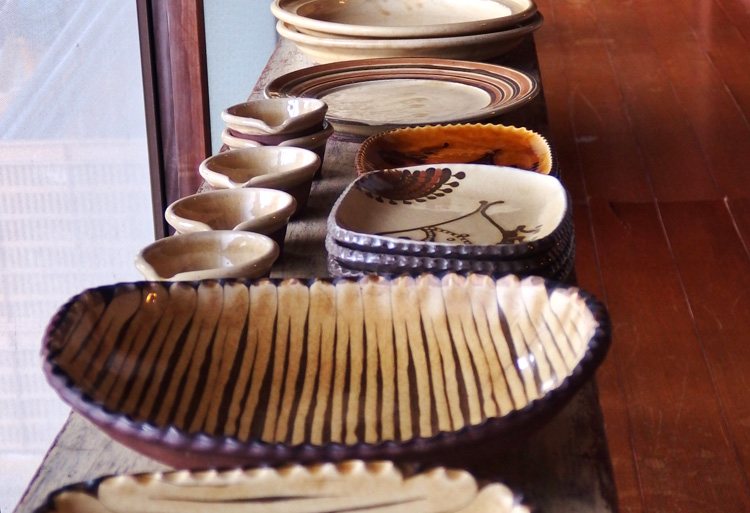
In anticipation of the two-person exhibition “Contemporary Iroe and Slipware: Hanako Kusaka × Yoji Yamada,” starting on April 20, 2016, we spoke with ceramic artist Yoji Yamada. His encounters with ceramics, his time in England, and his discovery of slipware— and now, his pursuit of new challenges in ceramics. Yamada’s journey continues.

The Beginning of a Journey with Ceramics
Hanada: When did you first become involved in making things?
Yoji Yamada: My parents loved Shigaraki ware,
so my first experience was touching clay during a pottery workshop in Shigaraki when I was in elementary school.
But in high school, I was fascinated by chemistry because my teacher was such an interesting person.
He used to say things like, “Everything in the world can be explained through chemistry.”
I admired that, and it made me feel like I could find answers to things I hadn’t understood before.
So, I entered a science and engineering faculty at university.
However, once I began studying chemistry seriously, it turned out to be quite different from what I had imagined. (laughs)
It was really just about material properties—too physical.
In hindsight, I think I was looking for something more spiritual.
Since I’d always had some interest in pottery, I decided to take a year off in my third year of university to attend a training program in Shigaraki for future ceramic successors.
When I touched clay again, the feeling from my childhood came back instantly—it really surprised me.
That year became a major turning point for me.
After graduating, I worked for two years at a pottery in Shigaraki.
Hanada: You went to England to study ceramics after that, right?
Yoji Yamada:
Yes. I had admired British fashion and punk culture since I was a teenager and had always dreamed of going there— but it wasn’t because of British ceramics! (laughs)
After leaving the pottery, I started saving money to go to England.
I worked at an ice cream factory, a udon factory, and a yakitori restaurant—
several part-time jobs at once.
It took about a year and a half, and eventually I went to Maze Hill Pottery in Greenwich, London—
a place known for its view over the city.
Hanada: Did you already know your teacher, Lisa Hammond?
Yoji Yamada: No, I didn’t. I got her email address through an acquaintance and contacted her directly.
Hanada: That took courage!
Yoji Yamada: I figured if I asked to be her apprentice right away, I’d just be turned down, so I tried to let her get to know me little by little.
Hanada: (laughs) That makes sense.
Yoji Yamada: I actually went to England to meet her in person.
But my English was terrible—I could barely communicate.
Before meeting, I would write down what I wanted to say and bring it with me.
So I could express myself, but I had no idea what Lisa was saying! (laughs)
Even so, she accepted me, which I’m still grateful for.
Hanada: You must have noticed many differences between Japan and England.
Yoji Yamada: Yes, quite a few.
In Japan, the relationship between teacher and apprentice is very hierarchical,
but in England, it felt more equal.
If you consulted your teacher, they would listen, and they were open to suggestions too.
Also, I realized that many overseas potters have deep respect for Japanese ceramics—
much more than people in Japan might imagine. Japanese potters should feel proud of that.
Especially those in the UK doing unglazed ware—they’re openly aiming for the Six Ancient Kilns of Japan!
In that sense, they’re more straightforward about it than we are.
And the clay is different too.
For high-fire ware especially, Japan’s clay is much better, I think.

Encountering Slipware:
“This is what I want to make!”
Hanada: Slipware has recently attracted attention among younger generations. Lisa’s work isn’t slipware, though. How did you first encounter it?
Yoji Yamada: I think it was after I returned to university from my year in Shigaraki.
As a science student, I often stayed overnight in the lab for experiments, and there was a lot of waiting time.
One day I came across a poster online for a slipware exhibition held at the Osaka Museum of Folk Art in 2003.
It was a shock—I instantly felt, “This is what I want to make!”
I went straight to the museum.
It’s hard to explain, but the pieces felt big in spirit—generous and open.
Hanada: You could say they have a sense of embrace. Are there any particular slipware pieces you’re especially fond of?
Yoji Yamada: The most iconic one would be the piece held by Muneyoshi Yanagi in that famous photo (at the Japan Folk Crafts Museum).
Hanada: The contrast between the vertical and horizontal lines is wonderful.

Yoji Yamada: And this one here (pointing at a striped pattern in the photo).
I love how it’s slightly distorted.
It looks like it was drawn from the right, starting neatly but gradually shifting off balance—that’s what makes it so appealing.
The rounded inside feels nice too.
And I like this one as well (pointing at the triple-patterned piece).
Hanada: That rhythmic pattern of three is distinctive.
Yoji Yamada: Yes, all three have a beautiful glaze tone—soft and lustrous.
Since materials are different now, it’s difficult to recreate old techniques exactly using today’s Japanese clays.
We need to find new ways.
What I want to achieve isn’t just reproducing the surface look, but expressing the atmosphere and texture of those works.
Hanada: Slipware itself has a strong character. Within that, how do you see your own originality?
Yoji Yamada: I’m not trying to imitate old works, and I’m not a genius. I’d rather learn from the past and gradually build my own ceramics.
Hanada: Is there any technical aspect you particularly value in your work?
Yoji Yamada: Three things: glaze tone, rhythm, and the softness of the clay.
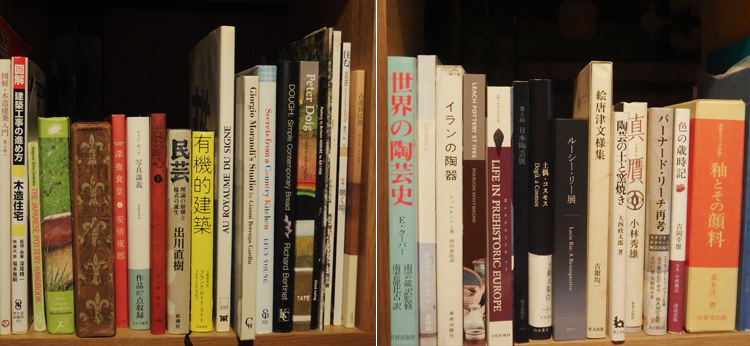
That quiet presence that seems to speak
when you live with it—
that’s what I want to express.
Hanada: What kind of slipware are you aiming for in the future?
Yoji Yamada: I want to express the feeling of slipware without actually using slip decoration.
Hanada: What do you mean?
Yoji Yamada: I believe even unglazed ware can carry the same atmosphere as slipware.
Hanada: What does that atmosphere mean to you?
Yoji Yamada: I think slipware has a raw, almost sensual side— different from the lightness of many contemporary pieces.
Hanada: Is that something you sense from old works?
Yoji Yamada: Yes, from old slipware pieces I have at home.
At first, I collected them as references, but once I brought them home, they started to “speak.”
You can’t feel that just by seeing them in a museum— it’s something that emerges when you live with them for a while.
That’s the feeling I want to express in my own work.
Hanada: Perhaps it’s something found in objects that have been cherished and survived through time. I think your balance between exploring the old and adapting to modern life is very healthy. Now, for the upcoming exhibition in April, you’ve made a variety of new pieces.
Yoji Yamada: Please take a look at some of the larger pieces, even though they may not be suitable for everyday use.
Some were made purely out of creative impulse,
so they might not be very practical—but I’d like people to see them anyway.
You don’t have to buy them, just come and take a look! (laughs)
Hanada: Those are often the pieces that touch people most deeply.
Yoji Yamada: If that’s the case, I’m truly happy.
Hanada: Thank you, and we look forward to your exhibition.

Exhibition: “Contemporary Iroe and Slipware”
Dates: April 20 (Wed) – 30 (Sat), 2016, 10:30am – 7:00pm
*Open every day during the exhibition period.
Photo:
Left: Yoji Yamada — front to back: Handle Mug / diameter 7.5 × height 8.5 cm (without handle),
Jug (M) / diameter 10 × height 18 cm (without handle)
Right: Hanako Kusaka — front to back: Sandersonia small bowl / diameter 11 × height 5.5 cm,
Sandersonia deep bowl / diameter 17 × height 19 cm
≪END≫

2016年4月20日からはじまる
「今様色絵とスリップウエア」日下華子×山田洋次 二人展に向けて
作者の山田洋次さんにインタビューをしました。
やきものとの出会い、イギリス
そして、スリップウェアとの出会い・・・
今目指すやきものへの挑戦。
山田さんの旅は続きます。

やきものの、旅のはじまり
花田: 山田さんがもの作りに関わるようになったのは、いつごろからですか。(以下 花田-)
山田: 両親が信楽の焼き物を好きだったこともあって、
小学生の時に、信楽の陶芸体験で土を触ったのが最初です。
でも、高校の化学の先生が面白い人で、最初は化学の世界に惹かれていました。
その先生、しゃべっている姿が魅力的で・・・世の中の全てのことは化学で説明が付く、
みたいなこと言うんですよ。憧れるし、それまで自分が理解できなかったことへの答えが
そこにあるような気がしたんです。大学も理工学部へ。
ただ、大学で本格的に化学の勉強を始めてみると、自分のイメージと随分違った(笑)。
僕自身の早とちりなんですが・・・実際は内容が物質的なこと一辺倒で。
今思えば、もっと精神的なことを期待していたんです。
で、元々興味もあったので、大学3年時に1年休学して
信楽で後継者育成のコースに1年通うことにしました。
土触ったら、小学校のときのあの土の感触が手によみがえって来るんです。あれには驚きました。
今思えば、あの1年が転機になりました。それで、大学卒業後は信楽の製陶所に二年勤めました。
-: イギリスに焼き物の勉強をしに行くのはその後ですね。
山田: はい、中高生の頃からイギリスのファッションやパンクに憧れていて、
いつか行きたいと思っていたんです。
元々はイギリスの焼き物に憧れていたわけではないんです(笑)。
で、製陶所をやめて、イギリスに行くためにお金を貯め始めました。
アイスクリーム工場、うどん工場、焼き鳥屋・・・バイトをいくつも掛け持ちしました。
1年半かかりました。で、展望台で有名なロンドンのグリニッチにある、メイズヒルポタリーへ。
-: 先生のリサ ハモンドさんとは元々面識があったのですか。
山田: ありません。知り合いにリサのメールアドレスを教えてもらって、連絡しました。
-: 勇気ありますね。
山田: いきなり弟子入りの話ししてもどうせ門前払いでしょうから、
少しづつ自分を理解してもらえるようにしました。
-: (笑)そりゃそうですね。
山田: 実際イギリスに会いにもいきました。
でも、英語はさっぱり。会話はほとんどできないんです。
だから、会う前に、伝えたいことだけ文章におこしておいて、それから会っていました。
言いたいことは言えるんですが、リサが言っていることはチンプンカンプン(笑)。
よく、受け入れてくれたと思います。
-: イギリスでは日本との違いも色々と見ることが出来たのではないですか。
山田: はい、色々ありました。例えば日本だと弟子と師匠ですが、イギリスではある意味対等。
相談すれば乗ってくれるし、こちらの提言も受け入れてくれる。
あと、国外に出て気が付いたんですが、海外の多くの陶芸家たちが想像以上に日本の焼き物に
敬意を持ってくれているということ。
これは日本の人たち、もっと誇りに思っていいかもしれません。
特にあっちで焼〆なんかやっている人は、思いっきり六古窯目指していますからね。
日本よりある意味ストレートかも知れません。あと、土も違う。
特に高火度のものは日本のほうがずっといいと思います。

スリップウェアとの出会い
「自分の作りたいものはこれだ!」
-: ところで、スリップウエアですが、最近は若い方たちの間でも注目を浴びています。
リサさんの仕事はスリップウエアではありませんよね。スリップウエアとの出会いは?
山田: あれは、信楽から休学を終えて大学に戻ったときだったと思います。
理系ですから実験で研究室に泊り込むんですが、待ち時間も多いんです。
で、インターネットで2003年大阪民芸館でのスリップウエアのポスターを、
たまたま目にするんです。
あれには衝撃受けました、自分の作りたいものはこれだ!って。一瞬にして感じました。
そのあと民芸館に飛んでいきましたよ。
うまく言葉で説明できないのですがうつわが大きい感じ。おおらかで。
-: 包容力とも言えそうですね。
山田さんの好きなスリップウエア、具体的にはなにが挙げられるでしょう。
山田: 分かりやすいところで言えば、
やはりあの柳宗悦さんが写真で抱えているもの(日本民藝館)でしょうか。
-: 縦と横の線の対比がいいですよね。

山田: そして、これ(写真を見ながら縞文様のものを指さして) 。
少しゆがんでくるのがいいんです。
多分右から描き始めていって、最初は規則ただしく描いているんだけど、
すこしづつずれていくのがいいんですよ。見込みの丸みも気持ちいい。
あと、これも好きかな(三連文様のものを指差して)。
-: 三連独特のリズム感です。
山田: 三つとも釉調がいいんですよね。柔らかくて艶っぽい。
材料も当時と違うので、日本の現在の原料で
当時の製法をそのまま再現するだけでは難しいでしょう。
今までに無い方法を考えるしかないと思います。
実現したいのは、そのものの表面的な見た目ではなくて、その雰囲気とか質感です。
-: さて、スリップウエアは、そのもの自体が非常に特徴的です。
そのスリップウエアという範囲で、山田さんにとって自身の独自性を意識されますか。
山田: 無理に昔のものを模すつもりもないし、僕は天才でもありません。
古いものを模しながら、自分の焼き物を少しづつ築いていきたいと思っています。
-: 仕事をする上で、技術的に大切にされていることはありますか。
山田: 釉調、リズム感、土の柔らかさ、の3つです。

暫くそばにいると語りだすような・・・雰囲気
そんな部分を表現したい。
-: 今後、山田さんが目指すスリップウエア、どのようなものなのでしょうか。
山田: スリップの技法を使わずにスリップの雰囲気を出したいんです。
-: と言うと?
山田: 僕、焼〆でもスリップウエアの持っている雰囲気は出せると思っているんです。
-: その雰囲気というのは、山田さんにとってどのようなものなのでしょうか。
山田: スリップウエアにもえぐい部分があると思っていて、最近の軽やかなうつわとは違う、
なまめかしさ、というか。
-: 古いものから感じることなのでしょうか?
山田: 家にある昔のスリップウエアから感じます。
最初は資料として選んでいることも多いのですが、
店で買って、自分の近くに置いておくと語りだすんですよ。
美術館などで見ているだけでは伝わってこない、暫くそばにいると語りだすような、
そういう部分を表現したいと思っています。
-: 昔から残っているもの、大事にされているようなものが持っているものなのでしょう。
山田さんは昔のものへの探究心と、現代生活への展開意欲のバランスが健全だと思っています。
さて、4月の企画展に向けてですが、新作も色々と作って下さいました。
山田: 日常使いには適さない大きなものも見て下さい。
制作欲のみで作ってしまったものも結構あって、見るからに使いづらいものも、見て欲しいです。
買っていただかなくてもいいので、是非見てみて下さい(笑)。
-: そういうもののほうが、人は心打たれるものです。
山田: それだったら、本当にうれしいです。
-: それでは企画展宜しくお願いします。

企画展名:今様色絵とスリップウエア
開催期間:2016年4月20日(水)~ 30日(土)午前10時30分~午後7時
※会期中無休
《写真》
左側:山田洋次 手前から、ハンドルマグ/胴径7.5×高さ8.5cm(取手なし)
ジャグ(M)/胴径10×高さ18cm(取手なし)
右側:日下華子 手前から、サンダーソニア小鉢/径11×高さ5.5cm、
サンダーソニア深鉢/径17×高さ19cm





